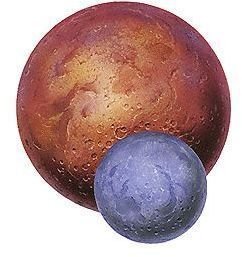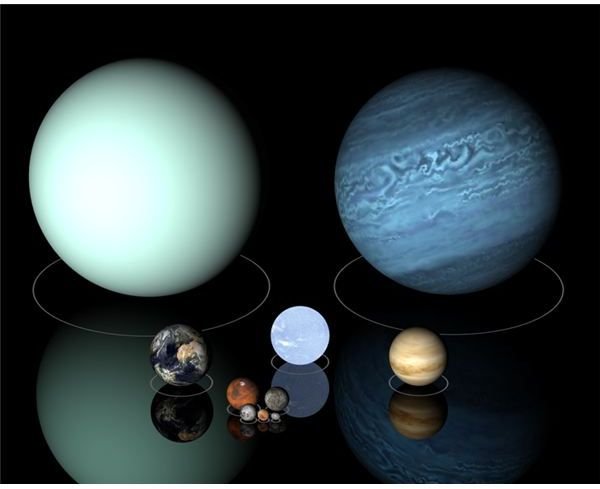Naming Celestial Bodies: How Do Planets and Moons Get Their Names?
So Who Names Celestial Bodies?
Formed in 1919 in Paris, France, the International Astronomical Union (IAU), is the body primarily responsible for either naming or ratifying the names of planets, moons and other astronomical bodies.
This organization is comprised of approximately 9,607 scientists of Ph.D. Levels or above. It also features 65 representatives of various nations. The IAU meets every three years and publishes its decisions in the Gazetteer of Planetary Nomenclature.
Within the IAU there are committees that are primarily responsible for individual suggestions to the larger body.
1. The Working Group for Planetary System Nomenclature (WGPSN) maintains the overall conventions and planetary nomenclature.
2. The Committee for Small Body Nomenclature (CSBN) handles smaller satellites.
Traditional Origins of Names
During the original convention in 1919, the IAU ratified the official names of the planets as they were traditionally named. Since ancient times, the closest planets to Earth in the solar system were named by Roman scientists. Mercury, Venus, Mars, Jupiter and Saturn have been known to exist and called by their present names for centuries. The origins of the names can be traced back to
ancient Sumerians and were ultimately adopted by the Greek civilization. The Roman Empire adopted the names and the civilization’s reach and influence ultimately established the names scientists use today.
One of the first controversies was regarding the Uranus. When Uranus was first discovered in 1781, Sir William Herschel named the planet George’s Star in honor of King George III of England. In response, French astronomers called it Herschel after the discoverer. It wasn’t commonly known as Uranus until around 1850, when German scientists attempted to return to traditional naming ideas. The debate between the countries ended when the HM Nautical Almanac Office adopted Uranus as the official name. The IAU upheld this position at its first convention.
Standards for Nomenclature
When naming planets or planetary features, either the IAU members or others may suggest a name for the planet or feature. These considerations are posted in newsletters and on the web site for the organization. Objections must be submitted within three months, otherwise the WGPSN submits the name for full IAU approval.
While there is little likelihood of discovery of new moons or satellites in the inner portion of the solar system, discoveries around Jupiter and Saturn continue. According to the IAU, any satellite around Jupiter must be named after one of Jupiter’s mythological lovers or descendants. Saturn’s satellites must be named after the Greco-Roman Titans or mythological monsters from Gallic, Inuit and Norse lore. Uranus diverges from the mythology spectrum by having its moons named after characters from Shakespeare plays and an Alexander Pope poem. Read more about Uranus’ moons in the article, The Literary Names of the Moons of Uranus.
Minor planets have the most elaborate naming methods:
- After four observations by astronomers, the Minor Planet Center issues a number for the body.
- Once this is established, the CSBN proposes a unique, one-word name of 16 characters or less. They cannot be named after political or military people or activities until 100 years after the person’s death or the event’s occurrence. Pet names and commercial interests are forbidden.
- In addition, specific criteria of the minor planet define names. Any body in resonance with Jupiter is named after heroes from the Trojan War.
- Minor planets not in resonance with either Jupiter or Saturn are named after centaurs.
- Any body near Neptune is named after a mythological creature of the underworld.
- Bodies further away from Netptune’s orbit are named after mythological creation.
- Also, any Near Earth Asteroid is given a mythological name of the Committee’s choice.
The Pluto Controversy

During the XXVIth General Assembly of the International Astronomical Union, Pluto was the main subject of controversy for the organization. Held in August 2006 in Prague, Czech Republic, a formal definition of planets was established. The decision of the International Astronomical Union resonated through the scientific community as the body needed to decide to either remove Pluto from the official registry or add three more planets. The International Astronomical Union ultimately decided to remove Pluto and create a new definition of dwarf planets, a body that orbits the sun and large enough to become rounded but still not fully outside the gravitational pull of another body.
The Future of the Convention
The International Astronomical Union will meet in Rio de Janeiro, Brazil in 2009 and Beijing, China in 2012. While there are no specifically scheduled events on par with the Pluto controversy, a few adjustments to the methods of naming planets and objects will be addressed.
The Committee for Small Body Nomenclature (CSBN) has addressed concerns over the continued naming of minor planets and small bodies within the solar system. Modern astronomical devices are capable of identifying objects as small as a single kilometer in diameter, opening up the path to a huge volume of potential naming issues. The International Astronomical Union will take the opportunity over the next two conventions to address whether the time has come to simply use numerical definitions for newly discovered bodies. In addition, the International Astronomical Union intends on addressing the issue of icy bodies within the solar system and beyond and whether to consider these minor planets or some other form of body.
Image Sources
Planetary comparison (Provided by Paul Stansifer via Wikimedia Commons; GNU Free Documentation License; https://en.wikipedia.org/wiki/File:1e7m_comparison_Uranus_Neptune_Sirius_B_Earth_Venus.png)
Artist’s impression of Pluto and Charon (Provided by NASA via Wikimedia Commons; Public Domain; https://en.wikipedia.org/wiki/File:Pluto_artistimpression.gif)
Resources
“How the Planets Were Named” Fact Monster: https://www.factmonster.com/ipka/A0875452.html
“Who Named the Planets?” Curious About Astronomy: https://curious.astro.cornell.edu/question.php?number=372
